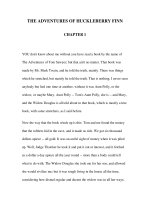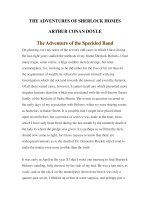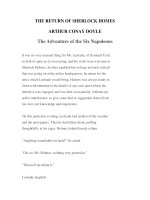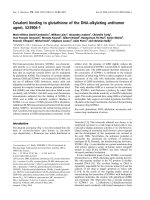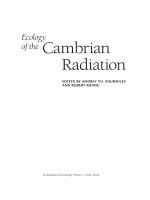The Ecology of the Cambrian Radiation - Andrey Zhuravlev - Chapter 1 doc
Bạn đang xem bản rút gọn của tài liệu. Xem và tải ngay bản đầy đủ của tài liệu tại đây (76.41 KB, 8 trang )
THE CAMBRIAN RADIATION, which commenced around 550 million years ago,
arguably ranks as the single most important episode in the development of Earth’s
marine biota. Diverse benthic communities with complex tiering, trophic webs, and
niche partitioning, together with an elaborate pelagic realm, were established soon af-
ter the beginning of the Cambrian period. This key event in the history of life changed
the marine biosphere and its associated sediments forever.
At first glance, abiotic factors such us climate change, transgressive-regressive sea
level cycles, plate movements, tectonic processes, and the type and intensity of vol-
canism appear very significant in the shaping of biotic evolution. We can see how rapid
rates of subsidence, as expressed in transgressive system tracts on the Australian cra-
ton, selectively affected the diversity of organisms such as trace fossil producers, ar-
chaeocyath sponges, and trilobites (Gravestock and Shergold—chapter 6); how glob-
ally increased rates of subsidence and uplift accompanied dramatic biotic radiation
by increasing habitat size and allowing phosphorus- and silica-rich waters to invade
platform interiors (Brasier and Lindsay—chapter 4); how climatic effects, coupled
with intensive calc-alkaline volcanism, at the end of the Middle Cambrian may have
caused a shift from aragonite- to calcite-precipitating seas, providing suitable con-
ditions for development of the hardground biota (Seslavinsky and Maidanskaya—
chapter 3; Eerola—chapter 5; Guensburg and Sprinkle—chapter 19); how the re-
organization of plate boundaries (Smith—chapter 2; Seslavinsky and Maidanskaya)
created conditions for current upwelling, which may in turn have been responsible
for the appearance and proliferation of acritarch phytoplankton and many Early Cam-
brian benthic organisms (Brasier and Lindsay; Ushatinskaya—chapter 16; Moldowan
et al.—chapter 21).
However, biotic factors themselves played a remarkable role in the environmental
changes that formed the background to the Cambrian radiation. We see how, by means
of biomineralization, shell beds and calcite debris contributed to the appearance of
hardground communities (Droser and Li—chapter 7; Rozhnov—chapter 11); how
CHAPTER ONE
Andrey Yu. Zhuravlev and Robert Riding
Introduction
01-C1099 8/10/00 2:02 PM Page 1
the intensification of bioturbation not only obliterated sedimentary structures but also
increased aeration of deeper sediments and provided more space for the development
of infauna (Brasier and Lindsay; Droser and Li; Crimes— chapter 13); how the Early
Cambrian biota changed the quality of seawater, thereby allowing the radiation of di-
verse phototrophic communities (Zhuravlev—chapter 8; Burzin et al.—chapter 10);
how the appearance of framework-building organisms created habitats for diverse
reefal communities (Pratt et al.—chapter 12; Debrenne and Reitner—chapter 14;
Riding— chapter 20); how the introduction of mesozooplankton in the Eltonian
pyramid (in addition to predator and herbivore pressure) produced a cascade of eco-
logic and evolutionary events in both the pelagic and benthic realms (Butterfield—
chapter 9; Zhuravlev); and, finally, how biotic diversity itself, together with commu-
nity structure, conditioned the intensity of extinction events and the timing and type
of abiotic factors that may have caused them (Zhuravlev).
This volume comprises 20 chapters, contributed by 33 authors based in 10 countries.
It has three themes: environment; community patterns and dynamics; and radiation
of major groups of organisms. The focus is the Cambrian period (tables 1.1 and 1.2),
but inevitably discussion of these topics also draws on related events and develop-
ments in the adjacent Neoproterozoic and Ordovician time intervals.
ENVIRONMENT
The theme of the environment traces plate tectonic developments, paleogeographic
changes, the history of transgressive-regressive cycles, sedimentary patterns, and cli-
mate change, as recorded in carbon, strontium, and samarium-neodymium isotope
curves, in the context of their influence on biotic development. The records of bio-
turbation and shell-bed fabrics, which provide links among physical, chemical, and
biologic processes, are included, and there are data on biomarkers.
COMMUNITY
The theme of community considers the biotas in their ecologic context, from their di-
versification to the development of planktonic, level-bottom, reef, hardground, and
deep-water communities.
RADIATION
The theme of radiation examines deployment of adaptive abilities by dominant Cam-
brian groups: brachiopods, cnidarians, coeloscleritophorans, cyanobacteria, algae,
echinoderms, hyoliths, lobopods, mollusks, sponges, stenothecoids, trilobites, and
other arthropods. Other common groups, such as acritarchs, chaetognaths, hemichor-
dates, conodont-chordates, various worms, and minor problematic animals, are not
2 Andrey Yu. Zhuravlev and Robert Riding
01-C1099 8/10/00 2:02 PM Page 2
INTRODUCTION 3
scrutinized separately, but aspects of their ecology are discussed within analyses of
particular communities.
Not all the views expressed in this book are in agreement, nor should they be. We hope
that comparison of the facts, arguments, and ideas presented will allow the reader to
judge the relative importance of abiotic and biotic factors on the dramatic evolution-
ary and ecologic expansion that was the Cambrian radiation of marine life.
This volume is a contribution to IGCP Project 366, Ecological Aspects of the Cam-
brian Radiation. In addition, this work has involved participants from IGCP Projects
303 (Precambrian-Cambrian Event Stratigraphy), 319 (Global Paleogeography of the
Late Precambrian and Early Paleozoic), 320 (Neoproterozoic Events and Resources),
368 (Proterozoic Events in East Gondwana Deposits), and 386 (Response of the
Ocean/Atmosphere System to Past Global Events).
MUSEUM AND REPOSITORIES ABBREVIATIONS
AGSO (Australian Geological Survey Organisation, Canberra, Australia), GSC (Geo-
logical Survey of Canada, Ottawa), HUPC (Harvard University Paleobotanical Collec-
tion, Cambridge, USA), IGS (Iranian Geological Survey, Tehran), MNHN (Muséum
National d’Histoire Naturelle, Paris, France), PIN (Paleontological Institute, Russian
Academy of Sciences, Moscow), SAN (Sansha Collections, J. Reitner, Göttingen, Ger-
many), SMX (Sedgwick Museum, Cambridge University, United Kingdom), UA (Uni-
versity of Alaska, USA), USNM (National Museum of Natural History, Smithsonian
Institution, Washington, DC, USA), UW (University of Wisconsin, USA).
REFERENCES
Bowring, S. A., J. P. Grotzinger, C. E. Isachsen,
A. H. Knoll, S. M. Pelechaty, and P. Kolo-
sov. 1993. Calibrating rates of Early Cam-
brian evolution. Science 261:1293–1298.
Davidek, K., E. Landing, S. R. Westrop,
A. W. A. Rushton, R. A. Fortey, and J. M.
Adrain. 1998. New uppermost Cambrian
U-Pb date from Avalonian Wales and the
age of the Cambrian-Ordovician bound-
ary. Geological Magazine 132:305–309.
Jago, J. B. and P. W. Haines. 1998. Recent ra-
diometric dating of some Cambrian rocks
in southern Australia: relevance to the
Cambrian time scale. Revista Española de
Paleontología, no. extraordinario, Home-
naje al Prof. Gonzalo Vidal, 115–122.
Landing, E., S. A. Bowring, K. Davidek, S. R.
Westrop, G. Geyer, and W. Heldmaier.
1998. Duration of the Early Cambrian:
U-Pb ages of volcanic ashes from Avalon
and Gondwana. Canadian Journal of Earth
Sciences 35:329–338.
Shergold, J. H. 1995. Timescales. 1: Cam-
brian. Australian Phanerozoic Timescales,
Biostratigraphic Charts, and Explanatory
Notes, 2d ser. Australian Geological Sur-
vey Organisation Record 1995/30.
Zhuravlev, A. Yu. 1995. Preliminary sugges-
tions on the global Early Cambrian zona-
tion. Beringeria Special Issue 2:147–160.
01-C1099 8/10/00 2:02 PM Page 3
4 Andrey Yu. Zhuravlev and Robert Riding
Table 1.1 Correlation Chart for Major Lower Cambrian Regions
Siberian Platform
Archaeocyath Zones
Archaeocyathus
abacus
beds
Syringocnema
favus
beds
Unnamed
beds
Trilobite Zones
(Stages)
Xystridura
templetonensis/
Redlichia chinensis
(Ordian/
Early
Templetonian)
Pararaia
janeae
Pararaia tatei
Abadiella
huoi
Pararaia
bunyerooensis
*525 Ma
Stages
Canglangpuan
Meishucunian
Qiongzhusian
Longwangmiaoan
Maozhuangian
Stages
*535 Ma
*545 Ma
Toyonian
Botoman
Atdabanian
Tommotian
Nemakit-
Daldynian
Amgan
Trilobite, Archaeocyath, and
Small Shelly Fossil Zones
Bergeroniellus
ketemensis
Bergeroniellus
asiaticus
Bergeroniellus
micmacciformis/
Erbiella
Anabarites
trisulcatus
1
1
1
1
1
1
4
2
2
2
2
3
3
3
4
4
Purella antiqua
Nochoroicyathus
sunnaginicus
Dokidocyathus regularis
Dokidocyathus lenaicus/
Tumuliolynthus
primigenius
Nochoroicyathus
kokoulini
Warriootacyathus
wilkawillinensis
Spirillicyathus tenuis
Jugalicyathus tardus
Retecoscinus
zegebarti
Carinacyathus pinus
Fansycyathus
lermontovae
Bergeroniellus
gurarii
Bergeroniellus
ornata
Lermontovia grandis/
Irinaecyathus shabanovi-
Archaeocyathus
okulitchi
beds
Anabaraspis
splendens
Schistocephalus
Trilobite and
Small Shelly Fossil Zones
Megapalaeolenus/
Palaeolenus
Drepanuroides
Yunnanaspis/
Yiliangella
Malungia
Eoredlichia/Wutingaspis
"Parabadiella"/
Mianxidiscus
Lapworthella/
Tannuolina/
Sinosachites
Siphogonuchites/
Paracarinachites
Anabarites/
Protohertzina/
Arthrochites
Redlichia nobilis
Redlichia chinensis
Hoffetella
Australia China
Yaojiayella
CB
EB
SB
2/3
*523 Ma
Stages
Spain
Leonian
Bilbilian
Marianian
Cordubian
Alcudian
Ovetian
Note: Approximate correlation of Lower Cambrian stratigraphic subdivisions for different regions,
modified from Zhuravlev 1995, and the positions of key Cambrian faunas: CB ϭ Chengjiang
fauna, EB ϭ Emu Bay Shale, MC ϭ Mount Cup Formation, SB ϭ Sinsk fauna, SP ϭ Sirius Passet
01-C1099 8/10/00 2:02 PM Page 4
INTRODUCTION 5
fauna. In addition, in some chapters the Waucoban corresponds to the Early Cam-
brian, and the Olenellid biomere is used for Atdabanian-Toyonian. Reliable radioiso-
tope ages from Bowring et al. 1993, Jago and Haines 1998, and Landing et al. 1998.
Stages
Hupeolenus
Sectigena
Antatlasia
guttapluviae
Antatlasia
hollardi
Daguinaspis
Choubertella
Eofallotaspis
Fallotaspis
tazemmourtensis
Cephalopyge
notabilis
Ornamentapsis
frequens
Trilobite Zones Trilobite Zones
Stages
Trilobite, Small Shelly Fossil,
and Ichnofossil Zones
Protolenus
Callavia
broeggeri
Camenella
baltica
Sunnaginia
imbricata
Harlaniella
podolica
Watsonella
crosbyi
No fauna known
No fauna known
"Ladatheca" cylindrica
"Phycodes" pedum
Branchian
Placentian
Albertella
Plagiura/Poliella
Bonnia/
Olenellus
"Nevadella"
"Fallotaspis"
"Kibartay"
Volkovia
dentifera/
Liepaina
plana
Acritarch Zones
Eccaparadoxides
insularis
Proampyx
linnarssoni
Holmia
kjerulfi
Holmia
inusitata
Schmidtiellus
mikwitzi
Rusophycus
parallelum
Platysolenites
antiquissimus
Sabellidites "Rovno"
Skiagia ornata/
Fimbriaglomerella
membranacea
Heliosphaeridium
dissimilare/
Skiagia ciliosa
Asteridium
tornatum/
Comasphaeridium
velvetum
Trilobite, Small Shelly Fossil,
and Ichnofossil Zones
Morocco Baltic Platform Laurentia Avalonia
Tissafinian
Banian
Issendalenian
SP
MC
*511 Ma
01-C1099 8/10/00 2:02 PM Page 5
6 Andrey Yu. Zhuravlev and Robert Riding
Table 1.2 Correlation Chart for Major Middle and Late Cambrian
Maozhuangian
Xuzhuangian
Zhangxian
Kushanian
Changshanian
Fengshanian
Xingchangian
Cordylodus lindstromi
Cordylodus prolindstromi
Hirsutodontus simplex
Cordylodus proavus
Mictosaukia perplexa
Lophosaukia
Rhaptagnostus clarki prolatus/
Caznaia sectatrix
Irvingella tropica
Stigmatoa diloma
Proceratopyge cryptica
Glyptagnostus reticulatus
Glyptagnostus stolidotus
Acmarhachis quasivespa
Glyptagnostus reticulatus
Pseudagnostus "curtare"
Pseudagnostus
pseudangustilobus
Ivshinagnostus ivshini
Oncagnostus longifrons
Oncagnostus
kazachstanicus
Oncagnostus ovaliformis
Neoagnostus quadratiformis
Trisulcagnostus trisulcus
Lotagnostus hedini
Dikelokephalina
Euloma limitaris/
Batyraspis
Lophosaukia
Harpidoides/Troedsonia
Eolotagnostus scrobicularis
Glyptagnostus stolidotus
Agnostus pisiformis
Erediaspis eretis
Holteria arepo
Proampyx agra
Ptychagnostus cassis
Goniagnostus nathorsti
Ptychagnostus punctuosus
Acidusus atavus
Triplagnostus gibbus
Xystridura templetonensis/
Euagnostus opimus
Doryagnostus notalibrae
Damesella torosa/
Ascionepea jantrix
Idamean
Mindyallan
Aysokkanian
Sakian
Batyrbayan
Iverian
Payntonian
Datsonian
Warendian
Australia
Ungurian
Kazakhstan & Siberia
Aksayan
Boomerangian
Undillan
Amgan
Floran
Late
Templetonian/
*495 Ma
Erixanium sentum
Wentsua iota/
Rhaptagnostus apsis
Rhaptagnostus clarki patulus/
Caznaia squamosa/
Hapsidocare lilyensis
Peichiashania secunda/
Peichiashania glabella
Peichiashania tertia/
Peichiashania quarta
Sinosaukia impages
Neoagnostus quasibilobus/
Shergoldia nomas
China
KF
Redlichia chinensis
Mayan
Leiopyge laevigata/
Anomocarioides
limbataeformis
Aldanaspis truncata
Anopolenus henrici/
Kounamkites
Schistocephalus
1
1
2
2
3
3
4
5
6
1
1
2
2
3
1
1
3
Corynexochus perforatus
Pseudanomocarina
Note: Approximate correlation of Middle-Upper Cambrian stratigraphic subdivisions for
different regions, modified from Shergold 1995, and the positions of key Cambrian
faunas: BS ϭ Burgess Shale, KF ϭ Kaili Formation, MF ϭ Marjum Formation, OR ϭ
orsten, WF ϭ Wheeler Formation. In addition, in some chapters the Corynexochid,
01-C1099 8/10/00 2:02 PM Page 6
INTRODUCTION 7
Rhabdinopora flabelliforme
Canadian
Ibexian
Sunwaptan
Steptoan
Marjuman
North America (Laurentia)
Trempealeauan
Franconian
Dresbachian
Albertian
Rhabdinopora
Yosimuraspis
Richardsonella/
Platypeltoides
Missisquoia perpetis
Mictosaukia
cf.
M. orientalis
Tsinania/Ptychaspis
Kaolishania pustulosa
Maladioidella
Changshania conica
Chuangia batia
Drepanura
Blackwelderia
Damesella/Yabeia
Leiopeishania
Taitzuia/Poshania
Amphoton
Crepicephalina
Bailiella/Lioparia
Poriagraulos
Hsuchuangia/Ruichengella
Shantungaspis
Yaojiayella
Scandinavia
Peltura transiens
Peltura
scarabaeoides
Peltura
Peltura minor
Protopeltura praecursor
Leptoplastus raphidophorus
Leptoplastus
paucisegmentatus
Parabolina spinulosa
Parabolina
Parabolina brevispina
Olenus dentatus
Agnostus
pisiformis
OR
MF
BS
WF
OR
Lejopyge
laevigata
Jinsella
brachymetopa
Hypagnostus parvifrons
Tomagnostus fissus/
Acidiscus atavus
Triplagnostus
gibbus
Eccaparadoxides
pinus
Glossopleura
Ehmaniella
Bolaspidella
Cedaria
Crepicephalus
Aphelaspis
Elvinia
Dundenbergia
Taenicephalus
Albertella
Eccaparadoxides
Paradoxides
paradoxissimus
Paradoxides
forchhammeri
Ptychagnostus punctuosus
Goniagnostus nathorsti
Olenus gibbosus
Olenus truncatus
Olenus wahlenbergi
Olenus attenuatus
Olenus scanicus
Olenus
Leptoplastus crassicorne
Leptoplastus ovatus
Leptoplastus angustatus
Leptoplastus stenotus
Leptoplastus
Peltura costata
Westergaardia
Acerocare ecorne
Acerocare
OR
Idahoia
Ellipsocephaloides
Saukiella pyrene/
Rasettia magna
Saukiella serotina
Eurekia apopsis
Missisquoia
Symphysurina
Saukiella junia
oelandicus
*492 Ma
Agnostus
pisiformis
China
(cont.)
Marjumiid, Pterocephaliid, and Ptychaspid biomeres are used for Amgan, Marjuman, Step-
toan, and Sunwaptan intervals, respectively. Reliable radioisotope ages from Davidek et al.
1998 and Jago and Haines 1998.
01-C1099 8/10/00 2:02 PM Page 7
01-C1099 8/10/00 2:02 PM Page 8

